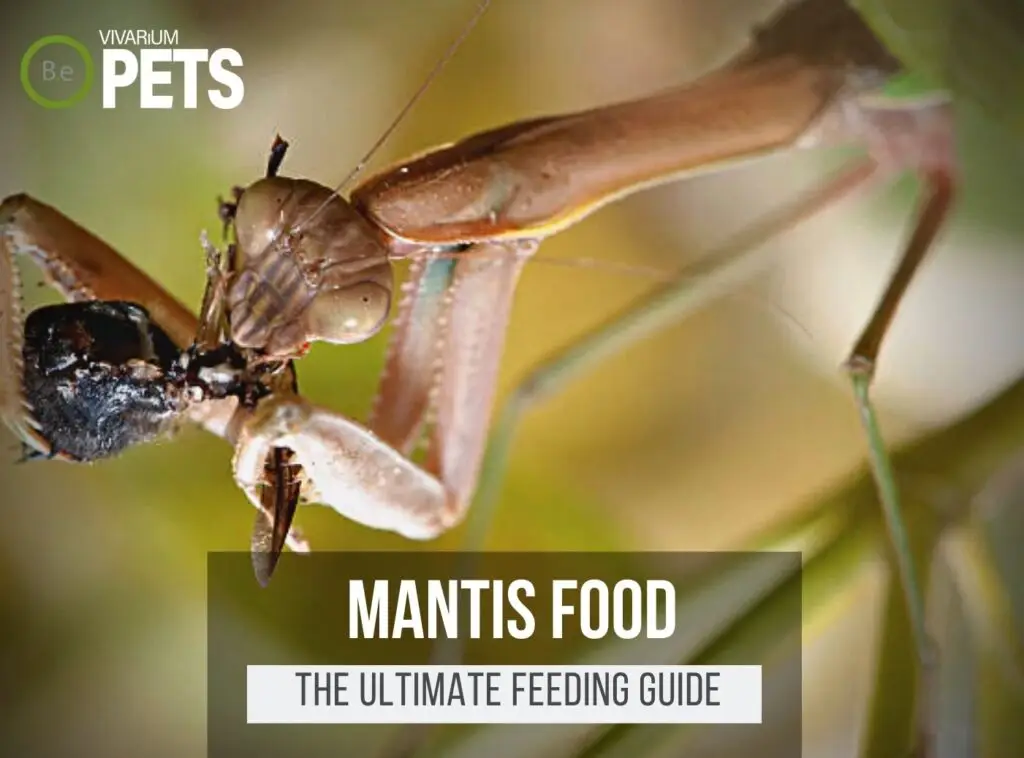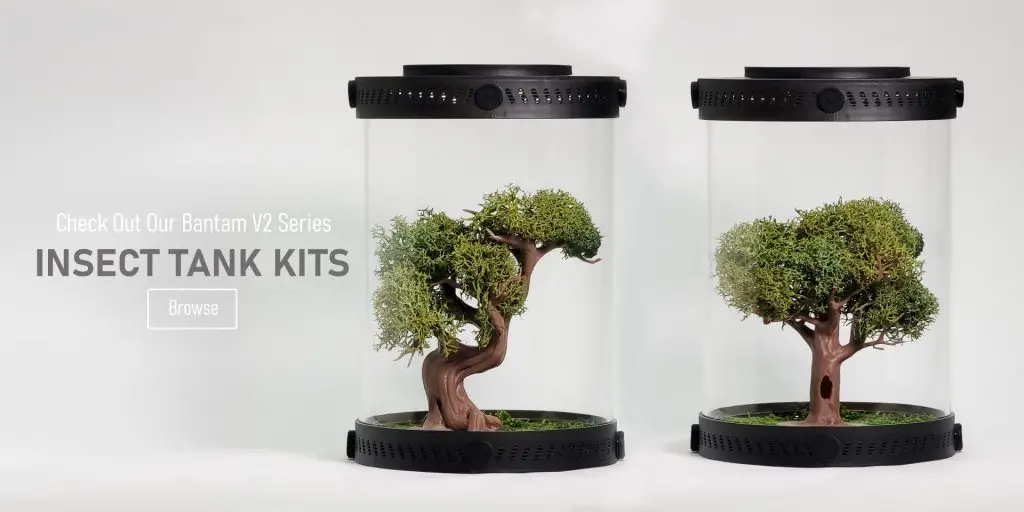Welcome to the world of mantis care! Thistle mantises are beautiful, exotic insects that are both popular and relatively easy to care for.
In this Blepharopsis mendica Care Guide, we will go through all of the essential details you need to know to make sure your flower mantis thrives.
From the preferred temperature and humidity to suitable enclosures, we’ve got you covered.
In no time, you’ll be an expert on Thistle Mantis care and the perfect bug parent.
Table Of Contents:
ToggleWhat Are Thistle Mantis?
B. mendica is a species of mantis that is commonly known as the Thistle Mantis.
Its scientific name is Blepharopsis mendica, and it belongs to the family Empusidae.
This type of praying mantis has a unique thistle-like pattern running down its abdomen and thorax, hence the name “Thistle Mantis”.
These mantises are native to sub-Saharan Africa and can range in color from light green to brown.
These slender, micro-sized mantises prefer to live in habitats with an abundance of vegetation where they can hide and wait for their prey.
What Does Thistle Mantis Look Like?
Thistle mantises are beautiful insects and have a unique and exotic appearance.
Their colors range from bright green to brown, and they have a slight striped pattern on their wings when viewed up close.
Blepharopsis mendica has two segmented eyes and long, slender antennae that help them find food.
They have powerful front legs for holding prey, and their thin, long bodies are typically just over 2 inches long.
Lastly, their wingspan is around 2 and a half inches long.
Benefits Of Using Thistle Mantis
Having Blepharopsis mendica in a vivarium can be a great way to bring vibrant color and movement to your enclosure.
In addition to their striking visual appeal, these fascinating insects provide excellent natural pest control, often preying on unwanted invertebrates like aphids and flies.
Thistle Mantis are hardy and low maintenance, making them a great option for beginner bug parents.
With the right setup and proper care, they can live relatively long lives in a captive environment.
Having a Thistle Mantis in a habitat is a surefire way to make your reptiles, amphibians, and other invertebrates feel right at home!

Thistle Mantis Facts
Blepharopsis mendica are small, slender-bodied mantis found mainly in parts of Africa and the Mediterranean.
These insects are known for their aggressive and territorial nature, but with proper care, they can live up to more than a year.
Thistle Mantis prefer a diet of small insects and benefit from a large enclosure with moderate humidity.
Although they are difficult to breed in captivity, they do have the ability to do so in the right conditions.
Habitat
The Thistle Mantis is a species native to North Africa, specifically the area around Morocco.
This mantis primarily inhabits dry, open grasslands, where temperatures are mild and food is plentiful.
Although these mantises are occasionally found living in damp forests, they are much less common there.
In their natural habitat, Blepharopsis mendica usually lives on low-lying plants and shrubs.
They prefer to be in direct sunlight, and their coloring is perfectly suited for camouflaging themselves in their environment.
The Thistle Mantis is a small species, struggling to survive alongside larger predators such as birds and lizards.
They have proven to be hardy insects and can survive a wide range of environmental conditions, making them popular subjects for scientific study.
Create the perfect home for your mantis with our Customizable Mantis Enclosure Kits, designed to meet all their habitat needs.
Diet
In their natural habitat, Thistle Mantis primarily feed on smaller insects such as aphids, grasshoppers, crickets, flies, and spiders.
To provide them with enough nutrition, they should eat at least once or twice a day.
In addition to insects, these mantids will occasionally consume small amounts of fruits or vegetables for additional vitamins and minerals.
Temperament
Thistle mantises are generally gentle, docile insects that are calm around humans and other animals.
They may become agitated if touched, so it’s best to avoid it.
However, they don’t have much of an urge to bite humans or bother pets and other animals.
Because of their passive nature, they may even make interesting pets for people who appreciate the beauty of nature.
Blepharopsis mendica can sometimes become aggressive toward one another, so it’s best to avoid housing them in the same enclosure.
Lifespan
The lifespan of a Thistle mantis is highly variable depending on the temperatures, humidity, diet, and overall health of the individual insect.
In ideal conditions, Blepharopsis mendica can live up to a year and a half!
Females typically live a few months longer due to the extra egg-laying and brooding that is necessary for them.
The life cycle of the Thistle Mantis includes 4 distinct stages: eggs, nymphs, adults, and death.
For the eggs, the female mantis will lay several hundred eggs in a foam or waxy egg sac.
After hatching, the nymphs will molt through several instars before reaching full adulthood.
At adulthood, mantises are capable of reproducing and strong enough to hunt their prey.
Eventually, as the mantis ages, they will reach the death stage.
Breeding
Blepharopsis mendica prefers to mate during warm weather, typically when the temperature is around or above 70 degrees Fahrenheit.
During mating season, the female typically has egg sacs attached to her abdomen.
She will then release a pheromone to attract the attention of males. Usually, a female will lay 80-100 eggs in one or two batches.
Once fertilized, these eggs will remain attached to a perch nearby until they are ready to hatch.
Once the eggs have hatched the nymphs will fend for themselves.
They will grow in stages, molting several times as they mature and become adults.
Where To Find Thistle Mantis
If you’re interested in introducing Blepharopsis mendica into an enclosure, you’ll need to know how to locate them.
Thistle mantises are generally found in Africa and the Middle East, though they are quite rare.
The easiest way to get your hands on one is to buy it. There are a variety of online vendors that specialize in exotic insects such as these.
Another option is to ask your local pet store, as they might know of a breeder or supplier who carries these species.
If you know of any dedicated insect enthusiasts or a local entomology club, they might be able to point you in the right direction.
Thistle Mantis Care
Caring for a Thistle Mantis is a rewarding experience that requires patience and understanding.
It is crucial to create an appropriate habitat with the correct temperature and humidity levels, suitable enclosure size and setup, and a natural diet of appropriately sized bugs.
Additionally, it is good to learn how to handle, feed, and water them correctly to ensure their health and safety.
With the right care and consideration, you can help B. mendica thrive in its environment.
Tank Requirements
As with all mantis species, the Thistle Mantis needs a safe and comfortable home.
A strong, clear terrarium with a secure lid and plenty of air circulation is ideal, as long as the tank isn’t too small that the animal can’t freely move around.
These mantises require low to moderate humidity (50%-60%) and higher temperatures (64°F – 82°F).
You should also keep the pH neutral within the range of 6.5 to 8.0. Use a substrate such as peat moss or coconut fiber, and make sure that it is kept moist but not damp.
For terrarium lighting, there is no need to provide additional heat as the mantises do not require daily UVB.
Instead, you can provide an LED bulb or other form of indirect lighting for the tank.
What Does Thistle Mantis Eat?
Feeding your Thistle Mantis is an essential part of their care. Here are some tips and advice on how to ensure they are getting the nutrition they need.
The best way to feed your mantis is to offer it live insects that are appropriate for its size.
They will generally eat any type of insect, such as crickets, flies, roaches, and moths.
It is a good idea to feed them a variety to make sure they are getting all of the nutrients they need.
It is not recommended to feed them mostly fruits or vegetables as they do not digest them well and they can cause stomach issues.
Some other things you can feed Blepharopsis mendica include waxworms, butterworms, and mealworms.
If you’re looking for a more detailed approach to feeding these critters, be sure to check out my ultimate DIY Praying Mantis food guide. I give a more in-depth explanation of the best foods and my favorite recipe.
Best Tankmates For Thistle Mantis
When it comes to tankmates for Blepharopsis mendica, certain species make great roommates.
Terrarium snails are an ideal companion because both species have similar needs in terms of humidity and temperature.
Worms can also be kept with Thistle Mantis, as they are a good source of protein and do not pose any safety risks.
Conclusion
Now that you’re armed with the knowledge of Blepharopsis mendica care, you can confidently embark on your journey to becoming an expert bug parent.
With the right setup, temperature, humidity, and diet, Thistle Mantises can be a great addition to your home.
But if you ever find yourself in doubt or simply need a refresher, come back to this guide to make sure your pet praying mantis is well taken care of.
Happy bug parenting!
Create the ideal habitat for your praying mantis with our species-specific soil mixes and Insect Enclosure Kits. These products provide everything you need for a thriving Mantid habitat.
Frequently Asked Questions
The Thistle Mantis (Blepharopsis mendica) is a medium–sized species of praying mantis, usually growing to a size of about 1.7 to 3.5 inches in length.
Thistle mantis are typically generalists that feed on a variety of small insects, such as small flies, cricket, moths, grasshoppers, and spiders.
The thistle mantis is native to regions in North Africa.
The thistle mantis typically inhabits dry, soil-based habitats such as bare ground, short grass, fields, forest clearings, and abandoned gardens. They prefer bright, sunny areas and avoid dark and moist habitats.





